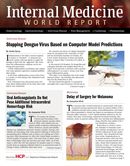Publication
Article
Internal Medicine World Report
Perspectives: Remove Language Barriers to Ensure Best Patient Care
Author(s):
In a perspectives piece published in the April 2015 issue of JAMA Internal Medicine, physicians from Montefiore Medical Center in New York City underscored the importance of removing language barriers.

In a perspectives piece published in the April 2015 issue of JAMA Internal Medicine, physicians from Montefiore Medical Center in New York City underscored the importance of removing language barriers.
The authors discussed an incident where they treated a patient who presented with a “feeling of slow heart beat” and dizziness. The patient’s native language was not English. His medical history indicated he had diabetes and hypertension. The patient had a presyncopal event and subsequently an electrocardiogram indicating third-degree atrioventricular block. By the time the authors met with the patient, other physicians in cardiology had decided to insert a pacemaker.
The authors were concerned about the patient’s bradyarrythmia and decided to explore his medical history more. Fortunately, they were able to communicate with the patient in his native language. They discovered that he had been taking 100 mg of Lopressor twice daily for 3 or 4 years.
The patient also reported that during the previous 3 weeks he had been taking 100 mg of metroprolol twice a day. Doctors at a different medical institution had prescribed metroprolol. The doctors asked the patient why he was taking 2 similar drugs (metoprolol is the generic name for Lopressor); he responded that he wanted to obey the doctor’s orders.
Upon discovering the error, the authors informed the cardiologists who halted preparations to insert the pacemaker. The doctors also explained the medication error to the patient, who was grateful for the doctors’ honesty.
The authors attributed the duplicative drugs to a language barrier, although duplicate medications are by no means restricted to non-Native speakers. They wrote, “Language barriers create situations with a higher risk of errors, both under-treatment and over-treatment.”
Experts encouraged hospitals to remove language barriers not just to ensure that patients get necessary care, but also to ensure patients do not receive unnecessary (and potentially dangerous) care.
This issue had been a national concern for years — some states require health care providers to provide interpreter if their non-English speaking populations exceed designated thresholds. Interpreters are helpful, as is recruiting and training bilingual providers.






